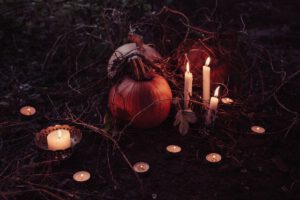SUNDAY, OCTOBER 31 and SUNDAY, NOVEMBER 1 and MONDAY, NOVEMBER 2—From Samhain to Mexico’s Day of the Dead to Halloween, world cultures celebrate the belief that at this time of year, the veil between this world and the next is particularly thin—and ancestors are held close. Don’t worry, it’s not all solemn and bone-chilling, though—today’s secular Halloween also brings out bright Jack-o-lanterns, loads of candy and a pretty good excuse for adults to join in on the fun with kids. So grab your best ghoulish mask and get the (Halloween) party started!
THE COVID-19 HALLOWEEN FORECAST
This year, the nation’s leading public-health experts are encouraging families to enjoy outdoor Trick or Treating. The most-shared advice in mid-October comes from Dr. Anthony Fauci, who declared:”Go out there and enjoy Halloween!” That line formed the headline of lots of subsequent newspaper and magazine stories. Fauci explained that during a typical Trick or Treat stroll, “You’re outdoors for the most part. Enjoy it. This is a time children love. It’s an important time of the year for children.”
In fact CNN has been predicting a Halloween “blowout.” CNN reported, for example: “The National Retail Federation expects Halloween spending to hit a record $10.14 billion. … Candy and chocolate sales are already soaring above 2020 levels, according to the National Confectioners Association, a trade group.”
Then USA Today detailed that spending: “Most of the spending will go to costumes: $3.32 billion, 27% more than last year and the most since consumers spent $3.35 billion in 2017. Almost as much–$3.17 billion–will be spent on decorations. And $3 billion will be spent on candy.”
However, that does not mean families can expect all of the typical pre-COVID traditions and events to be back on their regional schedules this year.
One big category of cancelations involves apartment complexes. Many high-rise complexes have cancelled Trick or Treating again this year, because children would be crowding into indoor spaces such as hallways and elevators. But the rules vary widely. Complexes with plenty of outdoor community space may still be holding events.
Bottom line: Check on any events in your community that you and your kids would like to attend.
Tips for Halloween Fun
One of the most highly recommended set of 2021 tips comes from The American Academy of Pediatrics’ website HealthyChildren.org, headlined: Halloween & COVID-19: Have Fun While Staying Safe. In addition to ideas for family fun, that list of tips ends with links covering food allergies and advice about face makeup and costumes that include decorative contact lenses.
Want even more ideas? Here are webpages packed with tips and resources from Nickelodeon and Nick Jr., Oprah Daily, Country Living, Good Housekeeping, Womans’ Day and even Ree Drummond’s The Pioneer Woman.
HALLOWEEN: A CHRISTIAN ORIGIN & A CULTURAL PHENOMENON
Allhallowtide, the triduum of Halloween, recalls deceased spirits, saints (hallows) and martyrs alike, in one collective commemoration. The word Halloween is of Christian origin, and many Christians visit graveyards during this time to pray and place flowers and candles at the graves of their deceased loved ones. The two days following All Hallows Eve—All Saints’ Day and All Souls’ Day—pay homage to the souls that Christians believe are now with God. In medieval England, Christians went “souling” on Halloween, begging for soul cakes in exchange for prayers in local churches.
Halloween’s secular side has emerged during the past century, and today, trick-or-treating, carving pumpkins, visiting haunted houses, watching horror movies and dressing up like favorite characters has become custom in Western culture.
SAMHAIN: GUISING FOR A TRICK
The original Samhain marked the end of the harvest season and ushered in winter, or the “darker half” of the year, in Gaelic Ireland, Scotland and the Isle of Man. During this time of year, bonfires were lit for the purpose of divination and as a protective and cleansing measure. Legend has it that spirits could easily come to earth, and many people would leave out food and drink for the roaming entities.
In many households, ancestors were welcomed to the table with particular enthusiasm, and large meals were prepared. Multiple sites in Ireland were, and still are, associated with Samhain, and the spirits that emerge there at this time of year. Guising—donning a costume—was thought to “trick” ill-intentioned spirits roaming the streets near Samhain, and hallowed-out turnips were lit with a candle and placed in windows, their monstrous carved faces frightening bad spirits.
Today’s Samhain emerged as part of the late 19th century Celtic Revival, and Neopagans, Celtic Reconstructionist Pagans and Wiccans all celebrate the holiday, in slightly varying ways. Most keep the widespread traditions of lighting bonfires, paying homage to ancestors, welcoming the “darker” season and preparing feasts with apples, nuts, meats, seasonal vegetables and mulled wines.
MUERTOS: DAY OF THE DEAD
Vibrant decorations for Dia de los Muertos, or Day of the Dead, mark towns in Mexico and Latin American communities far and wide, as the lives of the departed are celebrated with vigor. The full festival of Dia de los Muertos typically lasts two or three days (in some regions, customs begin on October 31), and traditionally, November 1 pays tribute to the souls of children and the innocent while November 2 is dedicated to deceased adult souls. In Mexico, relatives adorn altars and graves with elaborate garlands and wreaths, crosses made of flowers and special foods. Families gather in cemeteries, where pastors bestow prayers upon the dead. For children, Dia de los Muertos celebrations mean candy like sugar skulls and once-a-year treats; music and dancing delight celebrants of all ages.
.
.
.



Tell Us What You Think